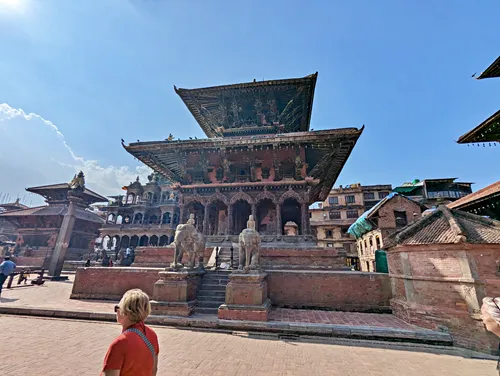Vishwanath Temple: Your Guide to Patan Durbar Square's Shiva Temple - Nepal Purple Travel Guide
(map, reviews)
This is Premium Content! To access it, please download our
Backpack and Snorkel Purple Travel GuideOrigin of the Name Vishwanath Temple
The name ‘Vishwanath’ comes from Sanskrit, meaning ‘Lord of the Universe’, a title often associated with Shiva in his universal form. The temple is named after the famous Vishwanath Temple in Varanasi, India, reflecting the widespread devotion to Shiva and the cultural connections between Nepal and the Indian subcontinent.

Here at Backpack and Snorkel Travel Guides, we typically promote self-guided walking tours.
But we realize that not everybody likes to walk by themselves in a foreign city. So, just in case that you rather go with ab guide: NO PROBLEM! Please see the Viator tours below.
free GuruWalk tours
paid Viator tours
The History and Architecture of Vishwanath Temple
The Vishwanath Temple in Patan was commissioned during the reign of King Siddhi Narsingh Malla in 1627, a period marked by great artistic and architectural achievements in the region. Built in the classic Newar pagoda style, the temple features two tiered roofs, finely carved wooden struts, and intricate metalwork adorning its doors and windows.
A pair of stone elephants guards the entrance, a typical feature of important temples, symbolizing strength and protection. The temple’s exterior showcases detailed depictions of Shiva, including scenes of him in meditation and as Nataraja, the cosmic dancer.
Religious and Cultural Significance of Vishwanath Temple
Vishwanath Temple serves as an active place of worship for Hindu devotees, especially those devoted to Shaivism. Offerings of flowers, rice, and incense are regularly made at the shrine. During important festivals such as Maha Shivaratri, the temple draws many worshippers from around the city.
Back to your self-guided tour
Author: Rudy at Backpack and Snorkel
Bio: Owner of Backpack and Snorkel Travel Guides. We create in-depth guides to help you plan unforgettable vacations around the world.
Other popular Purple Travel Guides you may be interested in:
Like this Backpack and Snorkel Purple Travel Guide? Pin these for later:





